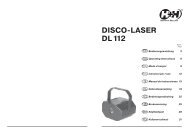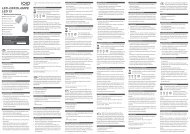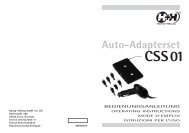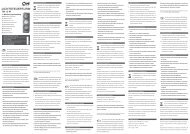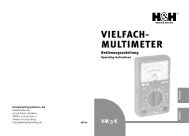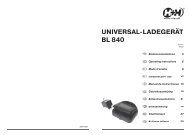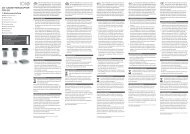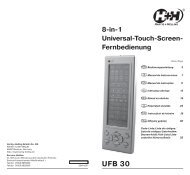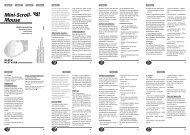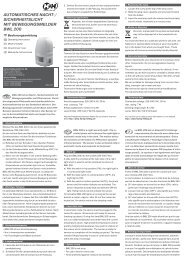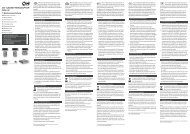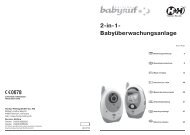BL 7 GS Universal-Ladegerät - Hartig + Helling GmbH & Co. KG
BL 7 GS Universal-Ladegerät - Hartig + Helling GmbH & Co. KG
BL 7 GS Universal-Ladegerät - Hartig + Helling GmbH & Co. KG
Create successful ePaper yourself
Turn your PDF publications into a flip-book with our unique Google optimized e-Paper software.
dass Ihren Akkus mehr Energie zugeführt würde<br />
als sie aufnehmen können (Überladung).<br />
6. Entladen<br />
Schieben Sie den Schalter (1) in die Position<br />
„ENTLADEN“.<br />
Legen Sie die zu entladenden Akkus in die Lademulden<br />
(4). Beachten Sie bitte, dass das<br />
<strong>BL</strong> 7 <strong>GS</strong> 9-V-Blockakkus nicht entladen kann.<br />
Die Entladezeit richtet sich nach dem Ladezustand<br />
des Akkus. Kontrollieren Sie bitte deshalb<br />
regelmäßig die Akkus mit der eingebauten<br />
Testlampe.<br />
7. Akku-/Batterietest<br />
Zum Testen benutzen Sie bitte die linke Lademulde<br />
(4). Nach dem Einsetzen des Akkus oder<br />
der Batterie schieben Sie den Schalter (1) in die<br />
Position „TEST“.<br />
Leuchtet die Lampe hell auf, so ist Ihr Akku bzw.<br />
Ihre Batterie noch geladen.<br />
Glimmt die Lampe nur noch oder verlischt sie<br />
ganz, so ist der Akku oder die Batterie leer und<br />
muss geladen werden.<br />
9-V-Blockakkus können nicht getestet werden.<br />
8. Entsorgungshinweis<br />
Altgeräte, die mit dem abgebildeten<br />
Symbol gekennzeichnet sind, dürfen<br />
nicht mit dem Hausmüll entsorgt werden.<br />
Verbrauchte Batterien<br />
und Akkumulatoren (Akkus),<br />
die mit einem der<br />
abgebildeten Symbole gekennzeichnet sind,<br />
dürfen nicht mit dem Hausmüll entsorgt werden.<br />
Sie müssen sie bei einer Sammelstelle für Altgeräte,<br />
Altbatterien bzw. Sondermüll (informieren<br />
Sie sich bitte bei Ihrer Gemeinde) oder bei<br />
Ihrem Händler, bei dem Sie sie gekauft haben,<br />
abgeben. Diese sorgen für eine umweltfreundliche<br />
Entsorgung.<br />
9. Pflege und Gewährleistung<br />
Trennen Sie das Gerät vor dem Reinigen gegebenenfalls<br />
von anderen Komponenten und verwenden<br />
Sie bitte keine aggressiven Reiniger.<br />
Das Gerät wurde einer sorgfältigen Endkontrolle<br />
unterzogen. Sollten Sie trotzdem Grund zu einer<br />
Beanstandung haben, senden Sie uns das Gerät<br />
mit der Kaufquittung ein. Wir bieten eine Gewährleistung<br />
von 3 Jahren ab Kaufdatum.<br />
Für Schäden, die durch falsche Handhabung,<br />
unsachgemäße Nutzung oder Verschleiß verursacht<br />
wurden, übernehmen wir keine Haftung.<br />
Technische Änderungen sind vorbehalten.<br />
10. Technische Daten<br />
Eingang: 230 V/50 Hz; 4,8 W<br />
Ausgang: 4 x 1,2 V/120 mA; 2 x 9 V/13 mA<br />
Aktuelle Produktinformationen finden Sie auf unserer<br />
Internet-Seite http://www.hartig-helling.de<br />
Operating instructions<br />
<strong>BL</strong> 7 <strong>GS</strong> is a combined charger/discharger<br />
which can be applied for charging/discharging<br />
up to four cells of the<br />
following type: Mono, Baby, Mignon<br />
or Micro. It can also be used to charge<br />
a combination of the named types. In<br />
addition, it is possible to charge two<br />
9 V Block accumulators (5).<br />
Please note, however, that no Mono- or<br />
Baby cells can be placed in the charging<br />
box left and right beside the 9 V Block.<br />
The appliance is equipped with a test<br />
lamp (2) indicating the current state<br />
of the accumulator. Of course it is also<br />
possible to test ordinary batteries.<br />
1<br />
5<br />
2<br />
4<br />
4<br />
5<br />
4<br />
3<br />
4<br />
1. Charging<br />
Move the function switch (1) to position<br />
“LADEN”. Insert the batteries to be charged in<br />
the charging positions (4) and connect <strong>BL</strong> 7 <strong>GS</strong><br />
to mains supply. Make sure that the positive<br />
pole is on the red LED side (3) when inserting<br />
Mono, Baby, Mignon and Micro accumulators.<br />
Lighting up of LED confirms charging operation<br />
in the corresponding charging slot.<br />
We recommend use of the test lamp to check<br />
accumulators prior to charging and, if neccessary,<br />
discharge before recharging.<br />
You can thus avoid the so-called “memory effect”<br />
on NiCd accumulators as well as durability<br />
reduction through inadvertent overcharging of<br />
NiCd and NiMH accumulators.<br />
The battery charger does not possess a built-in<br />
charging timer. Please remove the accumulators<br />
from the <strong>BL</strong> 7 <strong>GS</strong> after charging to avoid<br />
reduction of durability or destruction of your accumulators.<br />
2. Safety information<br />
Attention: Never try to charge alkaline batteries<br />
or RAM cells (rechargeable batteries) as there<br />
is a risk of explosion!<br />
3. Charging times<br />
The charging time for the accumulators depends<br />
on their nominal capacity. To determine<br />
the charging time for your accumulators, please<br />
divide the imprinted capacity by the charging<br />
current and multiply the result by 1.4.<br />
For example a Mignon-NiCd accumulator with<br />
1200 mAh storage capacity needs a charging<br />
time as follows:<br />
1200 (mAh) divided by 120 (mA charging current<br />
of <strong>BL</strong> 7 <strong>GS</strong> in case of Mignon accumulator)<br />
and then multiplied by 1.4. The result is around<br />
14 hours charging time.<br />
The table below shows the typical charging<br />
times for the different accumulators.<br />
Rechargeable<br />
battery type<br />
Capacity<br />
Charging<br />
time<br />
Micro/AAA 600 mAh 7 hours<br />
Mignon/AA 1200 mAh 14 hours<br />
Mignon/AA 2000 mAh 24 hours<br />
Baby/C 3000 mAh 35 hours<br />
Mono/D 4500 mAh 52 hours<br />
9 V Block 150 mAh 15 hours<br />
4. Customer information<br />
Please note that all new NiCd and NiMH rechargeable<br />
batteries only reach their full capacity<br />
after approx. 4-6 charging operations.<br />
5. Important information<br />
Never attempt to charge your rechargeable<br />
batteries again after they have been charged as<br />
this could result of the destruction of both your<br />
rechargeable batteries and the charger. After<br />
the charging operation your batteries are optimally<br />
charged. Further charging would result in<br />
more energy being supplied to your batteries<br />
than they can store (overcharging).<br />
-4- -5-



